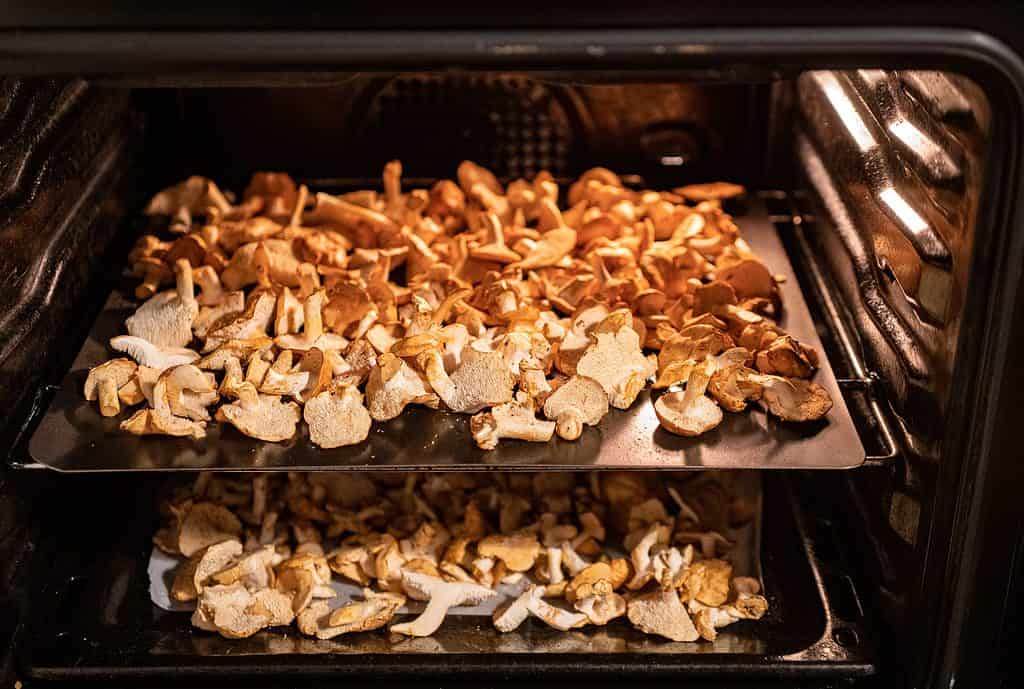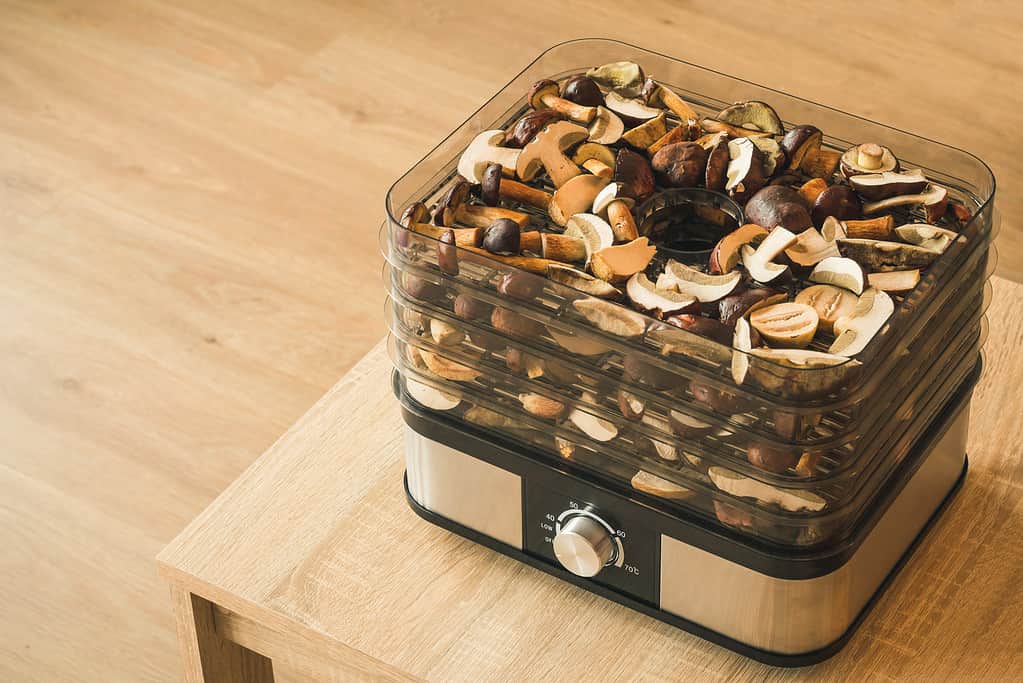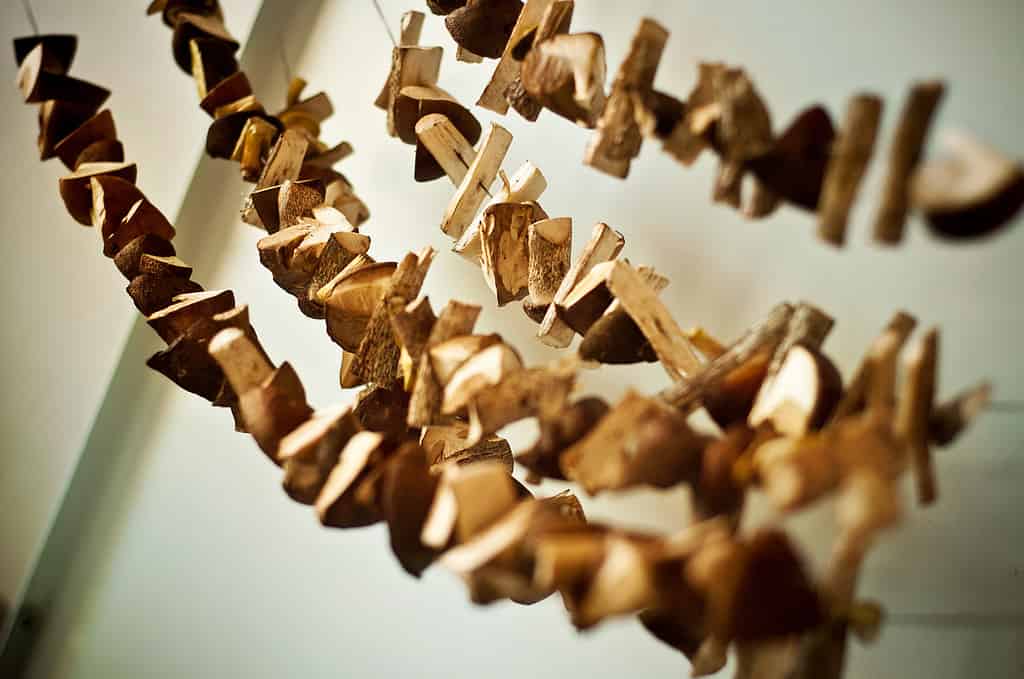Drying mushrooms is an excellent method for long-term food storage and culinary use. If you’ve never dried mushrooms at home before, you may not know where to start. Thankfully, we’ve got you covered!
In this guide, we’ll cover the benefits of drying mushrooms, how drying extends their shelf life, and provide three methods for dry preservation.
So, without further ado, let’s jump in!
Drying Mushrooms: What Are the Benefits?
There are a number of benefits you can get from drying mushrooms, whether purchased from a store or farmer’s market or foraged. You may have come across many packages of mushrooms on sale at your local grocery store, or perhaps you found a hard-to-access gourmet species at a farmer’s market on a trip out of town, and you’d like to bring a whole flat back home with you. Or maybe you’ve had a couple of bountiful days of foraging. Drying will ensure that you can significantly extend the usage of your mushrooms and ensure none of your bounty goes to waste. buy mushrooms online
Keep in mind, however, that while it’s tempting to scoop up all of the delicious choice hedgehog mushrooms you find on a foraging trip (or insert your favorite edible mushroom here), it’s important to leave some for the mushroom’s reproductive processes, as well as for all the other forest critters that use mushrooms as a food source.
In addition to extending the use of a large number of mushrooms, dried mushrooms that are rehydrated can add a wonderful concentration of flavor to a variety of dishes, and are particularly popular for use in soups and stews. When mushrooms such as shiitake are dried, their concentration of disodium guanylate, which produces the spectacular umami taste of this mushroom, increases. buy mushroom online usa
Dried mushrooms also make incredible soup stock bases. When rehydrating dried mushrooms in water, you can then use that water as a wonderfully savory base for soup, stews, and curries.
How Does Drying Extend the Shelf Life of Mushrooms?
By removing over 90% of the moisture in the mushrooms through the drying process, you can prevent the growth of bacteria, mold, and yeast that leads to food spoilage. It’s crucial, however, to not only properly dry your mushrooms, but properly store them, in order to successfully prevent rotting. If you dry them well, but then leave them in a bowl on the counter in your kitchen, you’ll soon see signs of mold. This is because there is enough moisture in the air to facilitate slight rehydration and microbial growth on your mushrooms.
Instead, you’ll ideally want to store your mushrooms in a cool, dark, dry area in a sealed container. Storing in a glass jar with a desiccant packet is a great choice. By keeping your dried mushrooms in these conditions, you are helping to prevent spoilage from the effects of heat, photodegradation, moisture, and oxygen. Depending on the storage conditions, you can expect your dried mushrooms to last between 4 months to one year.
Let it be known however that some mushrooms dehydrate better than others. The porcini is considered prized being sold dehydrated, while some people would never even think of buying chanterelles dehydrated.
Three At-Home Methods of Drying Mushrooms
So, you have a few options at your disposal for drying mushrooms at home. For all of these methods, it’s important to make sure the mushrooms are clean of any dirt, debris, and insects before starting the drying process. Rather than washing them, use a small brush or paper towel to clean them off. Below, we’ll talk about the steps for oven drying, using a dehydrator, and sun drying.
Oven Drying

Oven dehydrating is a popular method of drying foods that doesn’t require purchasing a dehydrator but is much faster than sun or air drying. Follow the below steps to get started:
- Preheat your oven to 140 degrees Fahrenheit or turn it to a keep-warm setting.
- Spread out your fresh mushrooms over parchment paper on a baking tray. You can either slice them or keep them whole. For shiitake, many people dry them whole or separate the cap from the stem, but keep the caps whole. For large chanterelles, you may want to slice them, keeping in mind that the thickness of the slices affects how long they will take to dry. Try to keep the mushrooms from touching (unlike the picture above) so that there is enough air space to aid in the drying process.
- Once the oven comes up to temp, put the tray in the oven for one hour.
- After an hour, remove the mushrooms from the oven and use a paper towel to blot away any moisture from the mushrooms that have been released from the drying process. and turn them over. Place them back in the oven for another hour.
- After this second hour in the oven, remove them and assess how they feel. When thoroughly dried, the mushrooms should be brittle and break easily.
- If they still feel leathery and don’t break easily, place them back in the oven, checking on them at 30-minute to one-hour intervals until they are the right consistency. Note that this timeline can range from 2-8 hours.
- Once they are brittle and thoroughly dried, allow them cool on the baking sheet until they are cool to the touch.
- Once completely cooled, you can now store your dried mushrooms in the proper conditions mentioned above.
Drying Mushrooms with a Dehydrator

If you have a dehydrator, you can certainly use it to dry your mushrooms. The benefits of using a dehydrator over an oven are (typically) faster drying time, higher quality results, and less energy use. This is due to most dehydrators having a system for heating and continuous air circulation. To dry your mushrooms using a dehydrator, use the following steps:
- Unless you’re dehydrating mushrooms that are less than 1/2″ thick whole, you should probably slice them when using a dehydrator. As a general rule, expect 1/4″ thick slices to take 3-6 hours, while 1/2″ thick slices often take 6-8 hours to fully dehydrate.
- Spread out your mushrooms on the dehydrator trays so that they are in a single, non-overlapping layer. As with the oven, allow air space between each mushroom.
- Set the dehydrator between 110-140 degrees Fahrenheit.
- Check on them after the 3-hour mark, assessing for brittleness.
- Once the mushrooms are thoroughly brittle and snap easily, they are done drying. Allow them to cool completely before storing them in appropriate conditions as mentioned above in this article.
Sun-Drying Mushrooms

Depending on the humidity of your home or local climate, this final option may not be feasible for everyone. However, this method is particularly well-suited for folks who live in drier regions. This method also works best in the heat of summer and has the added benefit of your mushrooms producing higher concentrations of vitamin D from sun exposure. To sun dry your mushrooms, follow the steps below:
- Ideally, plan to dry your mushrooms during a week with consistently sunny, rather than overcast days.
- Purchase or make screened trays. These will allow airflow to reach your mushrooms from the bottom of the tray as well as from the top and the sides.
- Place these trays on a table in an area that receives direct sunlight for at least 8 hours per day.
- Place your mushrooms’ spore-producing tissues (such as gills) face-up on the trays. Do this in a single, non-overlapping layer with space for airflow.
- Once the sun starts to go down, you’ll want to cover the trays with cardboard. This prevents any dew from accumulating on your mushrooms.
- Repeat this process for 3-10 days, depending on your environment and the size of the mushroom slices. If after a few days, your mushrooms don’t feel completely dry, your air humidity may be too high. At this point, it may be best to finish drying them in the oven or in a dehydrator.
Leave a Reply